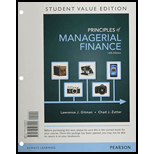
Principles of Managerial Finance, Student Value Edition Plus NEW MyLab Finance with Pearson eText -- Access Card Package (14th Edition)
14th Edition
ISBN: 9780133740912
Author: Lawrence J. Gitman, Chad J. Zutter
Publisher: PEARSON
expand_more
expand_more
format_list_bulleted
Concept explainers
Question
Chapter 13.4, Problem 13.15RQ
Summary Introduction
To discuss:
Significant factors in addition to quantitative factors where a firm considers in making decision of the capital structure.
Introduction:
The capital structure is the company’s total finances in their total operations and growth through multiple fund sources. The debt comes through the form of bond issues and long term notes payable, while the equity is segregated as common stock, preferred and
Expert Solution & Answer
Want to see the full answer?
Check out a sample textbook solution
Students have asked these similar questions
How does the weighted average cost of capital (WACC) affect a company’s valuation?
How do companies evaluate the feasibility of a project using NPV and IRR? I need help in this question.
What is the role of diversification in reducing portfolio risk? Need answer
Chapter 13 Solutions
Principles of Managerial Finance, Student Value Edition Plus NEW MyLab Finance with Pearson eText -- Access Card Package (14th Edition)
Ch. 13.1 - Prob. 1FOPCh. 13.1 - Prob. 1FOECh. 13.1 - What does the term leverage mean? How are...Ch. 13.1 - Prob. 13.2RQCh. 13.1 - What is operating leverage? What causes it? How do...Ch. 13.1 - What is financial leverage? What causes it? How do...Ch. 13.1 - What is the general relationship among operating...Ch. 13.2 - What is a firms capital structure? What ratios...Ch. 13.2 - In what ways are the capital structures of U.S....Ch. 13.2 - What is the major benefit of debt financing? How...
Ch. 13.2 - Prob. 13.9RQCh. 13.2 - Prob. 13.10RQCh. 13.2 - Prob. 13.11RQCh. 13.2 - How do the cost of debt, the cost of equity, and...Ch. 13.3 - Explain the EBIT -EPS approach to capital...Ch. 13.4 - Why do maximizing EPS and maximizing value not...Ch. 13.4 - Prob. 13.15RQCh. 13 - Prob. 1ORCh. 13 - Prob. 13.3STPCh. 13 - Canvas Reproductions has fixed operating costs of...Ch. 13 - Prob. 13.2WUECh. 13 - Prob. 13.3WUECh. 13 - Parker Investments has EBIT of 20,000, interest...Ch. 13 - Cobalt Industries had sales of 150,000 units at a...Ch. 13 - Prob. 13.5PCh. 13 - Prob. 13.24PCh. 13 - Prob. 13.25PCh. 13 - Prob. 13.26P
Knowledge Booster
Learn more about
Need a deep-dive on the concept behind this application? Look no further. Learn more about this topic, finance and related others by exploring similar questions and additional content below.Similar questions
arrow_back_ios
SEE MORE QUESTIONS
arrow_forward_ios
Recommended textbooks for you
 EBK CONTEMPORARY FINANCIAL MANAGEMENTFinanceISBN:9781337514835Author:MOYERPublisher:CENGAGE LEARNING - CONSIGNMENTPrinciples of Accounting Volume 2AccountingISBN:9781947172609Author:OpenStaxPublisher:OpenStax College
EBK CONTEMPORARY FINANCIAL MANAGEMENTFinanceISBN:9781337514835Author:MOYERPublisher:CENGAGE LEARNING - CONSIGNMENTPrinciples of Accounting Volume 2AccountingISBN:9781947172609Author:OpenStaxPublisher:OpenStax College Intermediate Financial Management (MindTap Course...FinanceISBN:9781337395083Author:Eugene F. Brigham, Phillip R. DavesPublisher:Cengage Learning
Intermediate Financial Management (MindTap Course...FinanceISBN:9781337395083Author:Eugene F. Brigham, Phillip R. DavesPublisher:Cengage Learning Financial Reporting, Financial Statement Analysis...FinanceISBN:9781285190907Author:James M. Wahlen, Stephen P. Baginski, Mark BradshawPublisher:Cengage Learning
Financial Reporting, Financial Statement Analysis...FinanceISBN:9781285190907Author:James M. Wahlen, Stephen P. Baginski, Mark BradshawPublisher:Cengage Learning

EBK CONTEMPORARY FINANCIAL MANAGEMENT
Finance
ISBN:9781337514835
Author:MOYER
Publisher:CENGAGE LEARNING - CONSIGNMENT

Principles of Accounting Volume 2
Accounting
ISBN:9781947172609
Author:OpenStax
Publisher:OpenStax College

Intermediate Financial Management (MindTap Course...
Finance
ISBN:9781337395083
Author:Eugene F. Brigham, Phillip R. Daves
Publisher:Cengage Learning


Financial Reporting, Financial Statement Analysis...
Finance
ISBN:9781285190907
Author:James M. Wahlen, Stephen P. Baginski, Mark Bradshaw
Publisher:Cengage Learning
Working capital explained; Author: The Finance Storyteller;https://www.youtube.com/watch?v=XvHAlui-Bno;License: Standard Youtube License